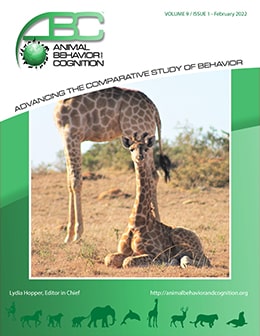Vol 9, Issue 1, February 2022
Social Network-Proximity Association: Preliminary Evaluation of Giraffe Sociality in a Zoo-Housed Group
Citation
Grasso, C., Poso, G., & Lenzi, C. (2022). Social network-proximity association: Preliminary evaluation of giraffe sociality in a zoo-housed group. Animal Behavior and Cognition, 9(1), 80-88. https://doi.org/10.26451/abc.09.01.07.2022
Abstract
Giraffes (Giraffa camelopardalis) are found in zoos all over the world. In recent years, numerous researchers have documented complex sociality in these mammals. They highlighted that giraffes have non-random preferences in their choices of social partners, which can depend on various factors such as age, sex, and kinship. One of the still little-known aspects is how the social structure of giraffes is formed in captivity. Moreover, the scientific literature about some aspects of the social structure of giraffes in captivity (i.e., proximity or affiliative interactions) is scarce. Our hypothesis was that there would be an association between the social network, based on affiliative reciprocal interactions, and physical proximity within a group of six giraffes (5 females and 1 male) living in a zoo. To test this hypothesis, in addition to the ethological observations, we also used a Geographical Information System (GIS) to study the position of the individuals within the daytime installation. Most of the giraffes had a high number of mutual dyadic interactions, which is connected to high group cohesion. Also, each individual actively selected social partners and formed non-random social bonds. Nevertheless, our hypothesis that there would be a social network–physical proximity association, was confirmed for one dyad and partially confirmed for the other two. The results of this study can be useful to increase the knowledge of giraffe sociality and to develop GIS as a new application in zoo studies.
Keywords
Affiliative, Giraffe, GIS, Proximity, Sociality
